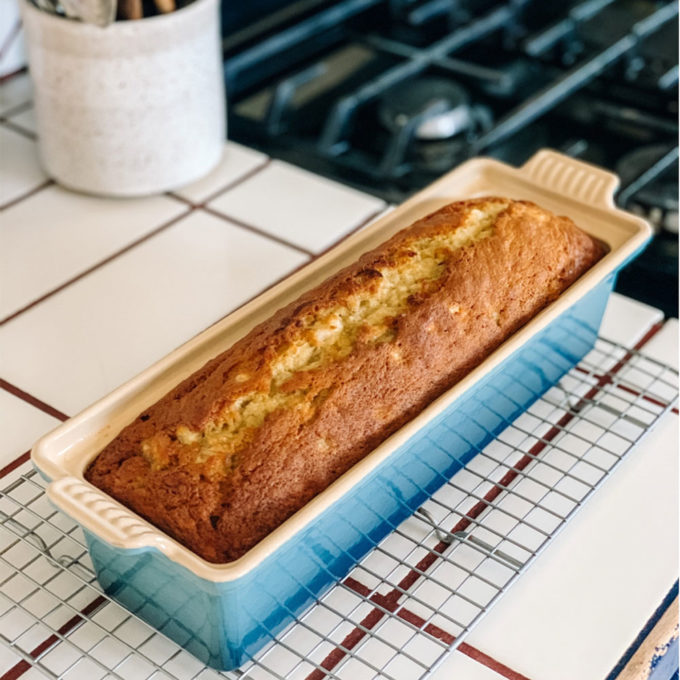
Some recipes, chefs make you because they know you crave them (think: warm chocolate cake; a really good steak). Then there are the recipes they’ve always adored. You’ll taste how much love is in the cooking of those dishes, whether it’s the sopes that remind one woman of her mother or the banana bread one chef loved so much he brought it to the menu of The French Laundry.
Here are five amazing chefs’ most beloved recipes, plus a few words about why this food means so very much to them.
Rice Congee, Melissa King

Chef Melissa King is perhaps best-known as the winner of Bravo’s Top Chef All Stars: Los Angeles Season 17, but she also (blows on knuckles) boasts the most challenge wins of any competitor in the history of Top Chef. Based in the Bay Area, her style combines Californian cooking with Asian flavors. She remembers:
My mom would start my mornings before school with this cozy bowl of savory rice porridge. It’s the chicken noodle soup of Chinese culture, and I like to make it on cold evenings or when I’m feeling nostalgic for home. It’s a simple, humble dish made of cooked rice and stock that can feed a big family on a budget. Choose the toppings according to your personal preference, but the garnishes are what make congee interesting! My suggestion is to use at least three or four toppings.)
Note: I like making congee with boneless, skinless chicken thighs, but you can use almost any protein you like, including peeled, deveined shrimp; ground beef, turkey or chicken; or white fish fillets, such as flounder or halibut. If you want to make the dish vegetarian, in addition to using mushroom or vegetable stock, substitute the chicken with shiitake or other mushrooms, smoked tofu, zucchini, peas or butternut squash.
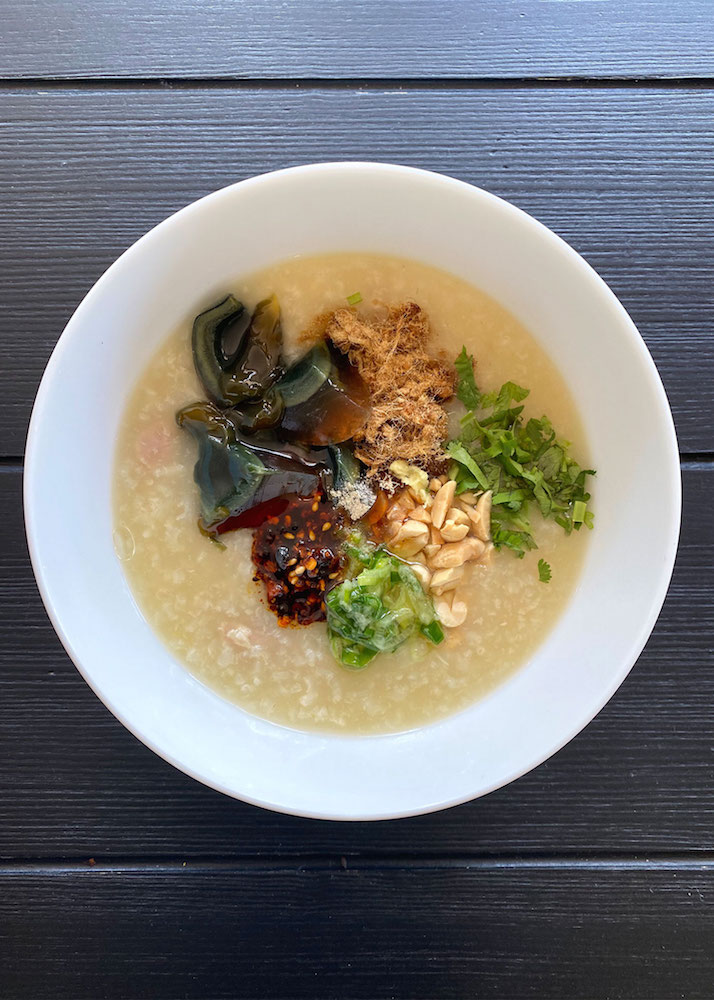
Rice Congee
- 2 Tbs. canola oil
- 1 small yellow onion, cut into 1/4-inch (6-mm) dice
- 3 garlic cloves, minced or grated
- 1 Tbs. peeled and minced or grated fresh ginger
- 1/2 cup (3 1/2 oz./105 g) uncooked short-grain or long-grain white rice, such as sushi rice or jasmine rice
- 2 1/2 to 3 quarts (2.5 to 3 l) stock of your choice
- 1 lb. (500 g) raw protein of your choice, such as boneless, skinless chicken thighs, cut into slices 1/4 inch (6 mm) thick or 3/4-inch (2-cm) dice
- Salt
- Ground white pepper (optional)
- 1 tsp. fish sauce (optional)
Garnish options:
- Chopped green onions
- Chopped fresh cilantro
- Crushed peanuts
- Fried garlic
- Century egg
- King’s Sichuan chili sauce or your favorite hot sauce
- Ground white pepper
- Grated fresh ginger
- Sesame oil
- Sweet soy sauce
- Pork floss
- Shredded iceberg lettuce
- Sliced radishes
In a 4-quart (4-l) pot over medium heat, warm the canola oil. Add the onion, garlic and ginger and sauté until soft and translucent, about 3 minutes. Add the rice and toast for 1 minute. Add the stock and bring to a boil. Reduce to a simmer and let the rice simmer, stirring often, until it’s broken down and emulsified together with the liquid, about 45 minutes. Add more water or stock if it’s too thick. The congee should be the viscosity of porridge, not soupy or watery.
After the rice has broken down into a congee-like consistency, add the chicken thighs and simmer until cooked through, about 15 minutes more. If using other proteins, add tougher and larger cuts like pork shoulder, bone-in legs and smoked turkey legs to the congee to simmer with the rice earlier in the cooking so there is time for the meat to break down into shreds. If using more delicate proteins like shrimp or fish fillets, add these during the last 3 minutes of cooking the congee; these proteins cook very quickly and you just want to lightly poach them in the congee before serving. Season the congee to taste with salt, white pepper and fish sauce, if using.
Serve the congee with the garnishes of your choice. Makes about 2 quarts (2 l); serves 2 to 4.
Banana Bread, Timothy Hollingsworth
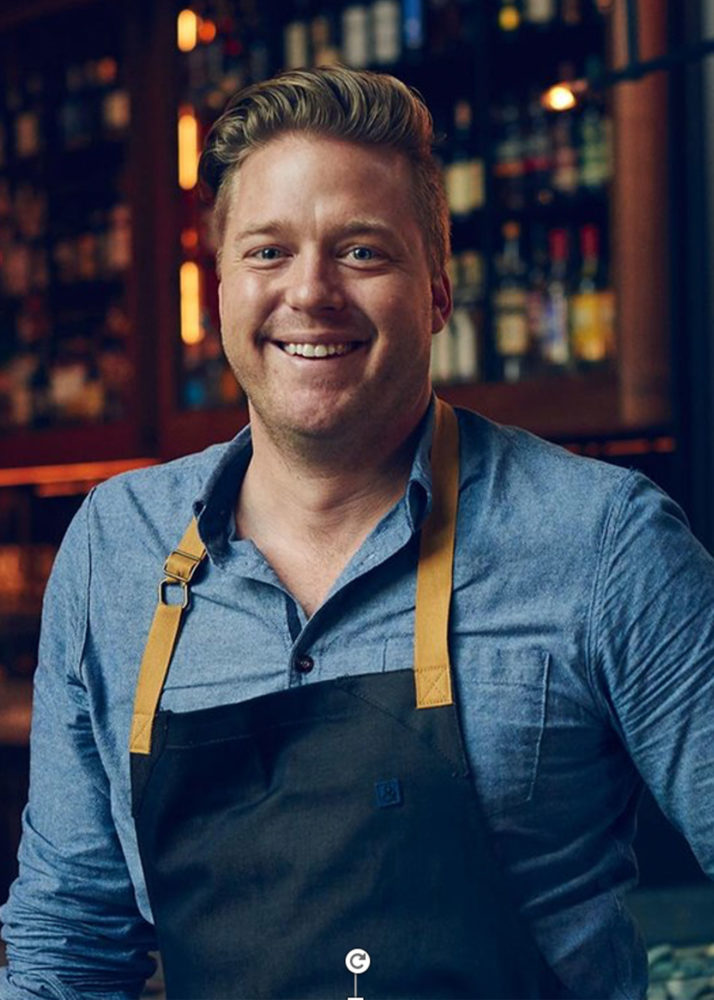
Chef Timothy Hollingsworth of Otium has a 13-year history in the Napa Valley region, but more recently has relocated to Los Angeles. Though he has studied under some of the most impressive chefs in the world, he remembers mom’s baking:
My mom’s banana bread—which is super-moist and easy to make—is one of my favorite recipes, and I’m excited to pass it down to my own kids. This recipe made it onto the menu of The French Laundry during my time there, and it was also served at some of my restaurants in Los Angeles. My mom doesn’t cook or bake anymore, so this is a special way to take me back to my childhood.
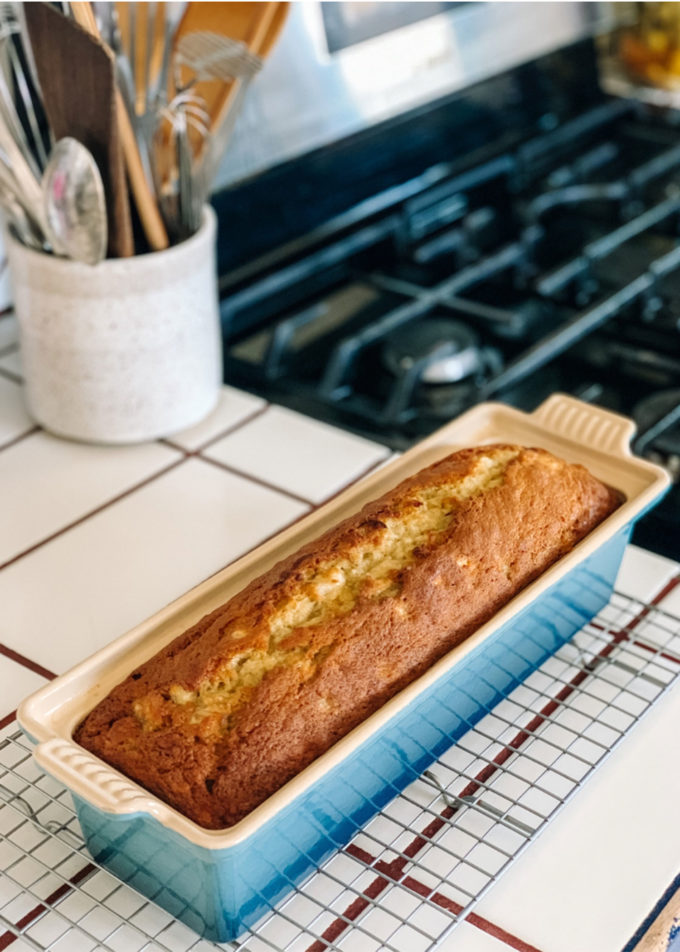
Banana Bread
- 1 cup (8 oz./250 g) sugar
- 1/3 cup (3 oz./90 g) unsalted butter, at room temperature
- 2 eggs
- 4 ripe bananas, mashed and cut into pieces
- 1/3 cup (3 fl. oz./80 ml) water
- 1 2/3 cups (7 oz./220 g) all-purpose flour
- 1 tsp. baking soda
- 1/4 tsp. baking powder
- 1/2 tsp. salt
Preheat an oven to 350°F (180°C). Grease a terrine dish or oven-safe baking dish with nonstick cooking spray or butter, then dust with flour.
In a bowl, using an electric mixer, cream the sugar and butter together until creamy. Add the eggs and beat until fluffy. Add the bananas and water and beat on high speed for 30 seconds. Add the flour, baking soda, baking powder and salt and beat until incorporated. Use a rubber spatula to mix in any remaining flour from the edges of the bowl. Do not overmix.
Pour the batter into the prepared pan and bake for 45 minutes, then insert a fork or a cake tester into the center of the loaf; it should come out clean. If not, continue baking until done, up to about 1 hour. Transfer the pan to wire rack and let cool for about 5 minutes, then turn the loaf out onto the rack and let cool completely. Cut into slices and serve. Makes 1 loaf.
Draniki, David Nayfeld
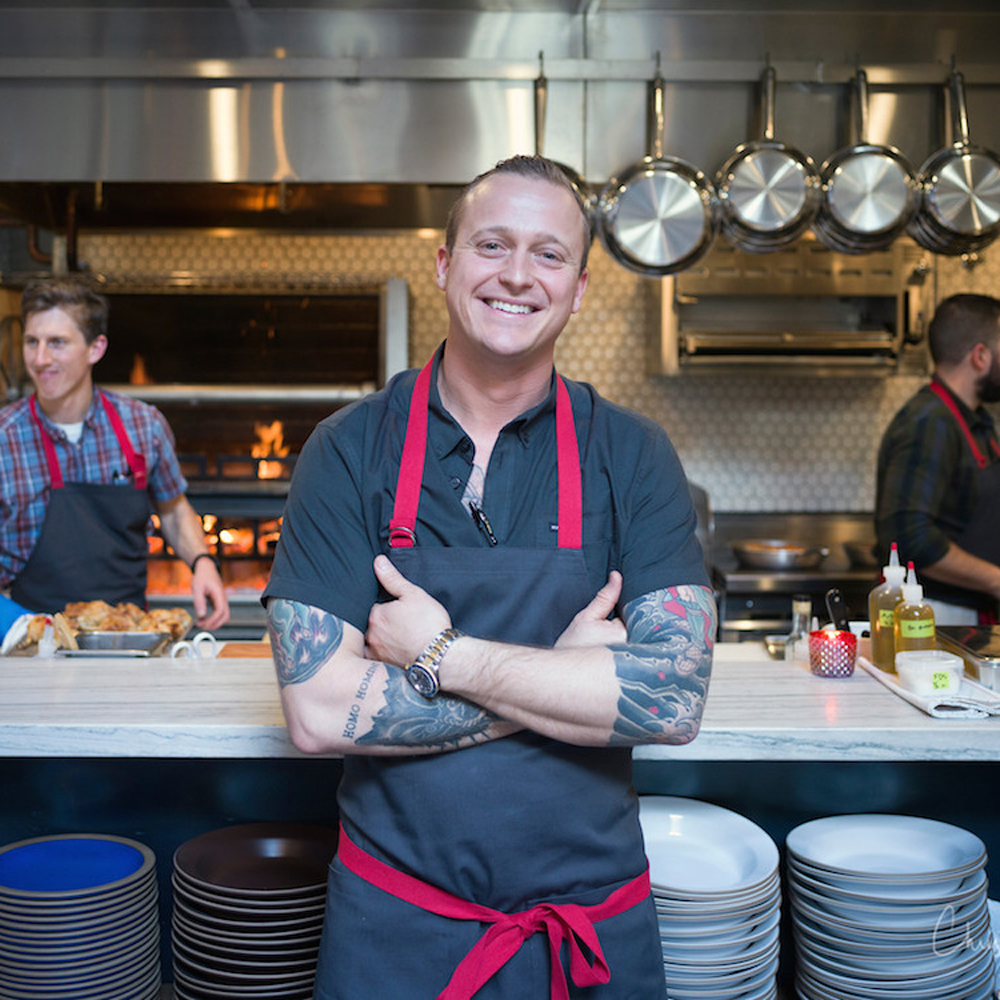
The Che Fico chef has gained a name for himself all over again taking care of loved ones during the recent national events. Here’s a recipe dear to his heart:
My family emigrated to America from Belarus where the potato pancake was not called a latke, but a draniki, which are ground potatoes instead of shredded. So, they have more moisture to them, like a potato batter, and on the inside is a beautifully ground chicken patty, which has a certain amount of chicken fat in it and some herbs and garlic… It reminds me of my childhood. Coming home and having a stack of these draniki in the kitchen, waiting for me.
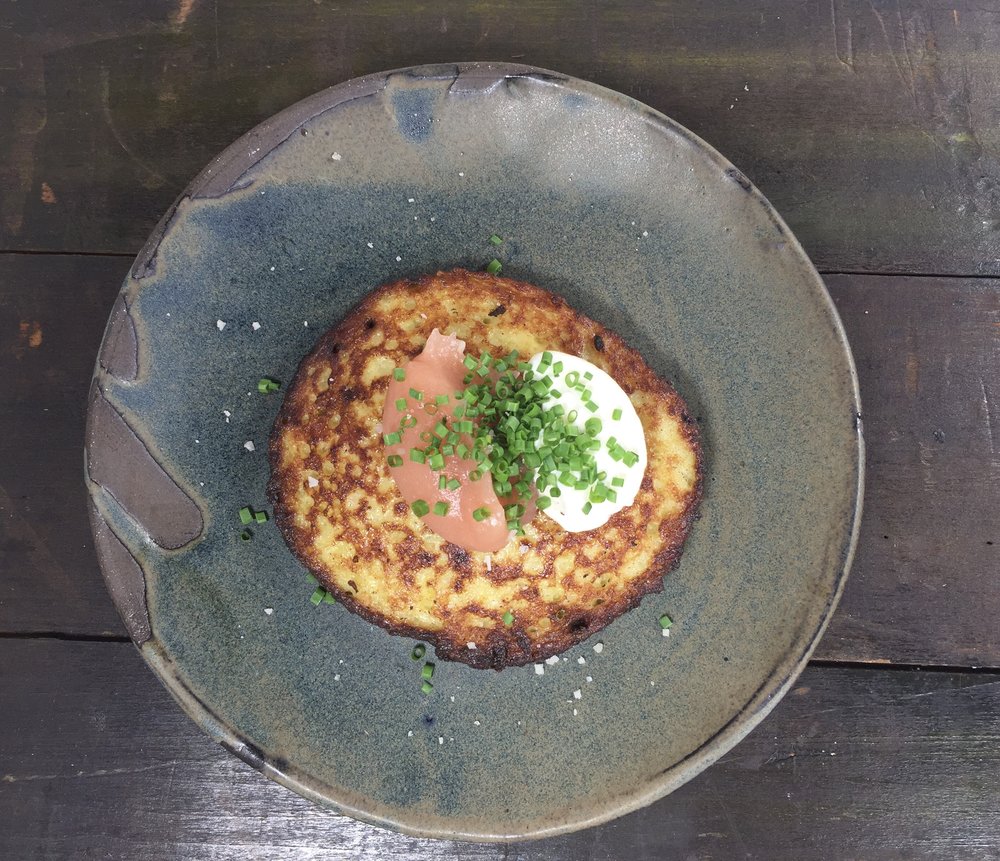
Draniki
Draniki is a Belarusian-style potato pancake stuffed with chicken. I originally developed this for The Inherited Plate recipe blog.
- 4 Yukon Gold potatoes, peeled
- 1 small yellow onion
- Kosher salt and freshly ground pepper
- 5 eggs
- 1/2 to 3/4 cup (2 1/2 to 4 oz./75 to 125 g) all-purpose flour
- 1/2 lb. (250 g) ground chicken
- 1 garlic clove, minced
- 1 1/2 Tbs. chopped fresh flat-leaf parsley
- Sunflower oil, as needed
- For serving:
- Applesauce or preserves
- Russian sour cream
- Sliced fresh chives
Cut the potatoes and onion into chunks and grind through the smallest holes of a meat grinder into a large bowl. Season well with salt and pepper. In a small bowl, lightly beat 4 of the eggs and add to the potato mixture along with 1/2 cup (2 1/2 oz./75 g) of the flour. Mix gently until blended.
If the mixture appears to have too much liquid, drain slightly until it resembles a lumpy, thick batter. As the mixture sits, the salt may extract more liquid from the potatoes, so add more flour as needed to keep that thick, lumpy texture.
In a medium bowl, combine the chicken, garlic, parsley and remaining egg. Season well with salt and pepper and mix well.
Preheat an oven to 400°F (200°C). Line a baking sheet with parchment paper. Line a second baking sheet with paper towels.
In a nonstick fry pan, pour in enough oil to generously cover the bottom of the pan for a shallow fry. Heat over medium-high heat until the oil is hot and appears thinner.
Add 2 tablespoons of the potato mixture to the pan. Reduce the heat slightly if needed to prevent burning. Gently bring any runaway bits of potato back to the pancake with a spoon or spatula.
Make a small divot or nest in the center of the pancake, making sure not to break through the batter. Add a spoonful of the chicken mixture and press down gently with your fingers. Add some additional batter over the chicken just to coat. Cook until the pancake is fluffy and dark golden brown, then gently flip over and cook the second side until golden, gathering up the bits as you did on the first side.
Transfer the pancake to the parchment-lined baking sheet. Continue cooking pancakes with the remaining batter. You can use up any additional batter or chicken to fry up little katleti, or chicken patties, or vegetarian potato pancakes.
Bake the pancakes for 8 to 10 minutes, then transfer them to the paper towel–lined baking sheet to drain.
Serve with applesauce or preserves, sour cream and chives. Makes 8 to 10 draniki.
Gumbo, Kwame Onwuachi

The Washington, D.C. chef is as talented as he is charismatic. A James Beard Award winner, his heritage and cooking nod to Jamaica, Nigeria, and he earned many plaudits at Kith and Kin, the restaurant he helmed until recently. He also co-authored the celebrated book Notes From a Young Black Chef: A Memoir. In it, he writes about gumbo. The Louisiana specialty holds a special significance and represents not just the resilience of his ancestors but the pride he feels for his African and Southern heritage. Originating in West Africa before making its way to Louisiana, this traditional recipe is a staple dish that has evolved with each passing generation.
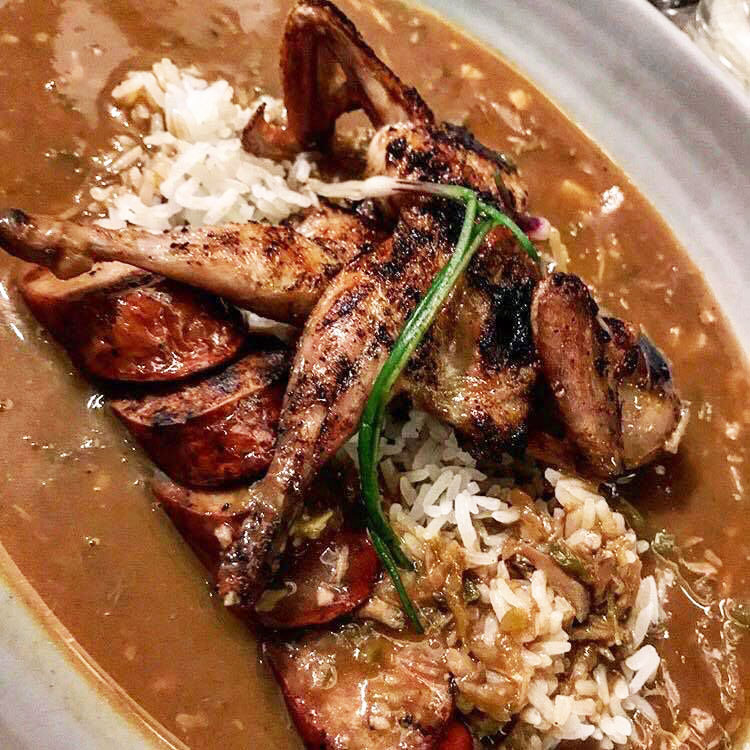
Gumbo and Thyme-Scented Rice
- 2 cups (4 sticks) (1 lb./500 g) unsalted butter, melted
- 2 cups (10 oz./315 g) all-purpose flour
- 1 1/2 cups (7 1/2 oz./235 g) finely diced yellow onion
- 1 cup (5 oz./155 g) finely diced celery
- 3/4 cup (3 3/4 oz./115 g) finely diced green bell pepper
- 2 Tbs. minced garlic
- 2 Tbs. canola oil
- Kosher salt
- 1 Tbs. Cajun spice
- 2 quarts (64 fl. oz./2 1) shrimp stock
- 1 quart (32 fl. oz./1 l) chicken stock
- 2 andouille sausages, 1 whole, 1 sliced
- 1 whole chicken, quartered and skinned
- 5 blue crabs, cut in half
- 2 cups lump crabmeat
Preheat an oven to 350°F (180°C).
To make the roux, in an ovenproof loaf pan, whisk together the butter and flour until smooth. Bake, uncovered, stirring every 30 minutes, for about 2 hours. Reserve half of the roux for the gumbo; the remainder can be kept in the freezer for up to 3 months.
In a large saucepan over medium-high heat, warm the canola oil. Add the onions, celery, green bell pepper, garlic and a pinch of salt and sauté until tender. Add the Cajun spice and stocks and bring to a simmer. Slowly whisk in the roux to create a thick, smooth liquid.
Add the whole sausage and chicken and simmer for 20 minutes. Add the crab halves and simmer for 20 minutes. Season to taste with salt. Skim off the excess oil as needed. Remove the whole sausage and add the crabmeat and sliced sausage.
Serve the gumbo with the thyme-scented rice. Serves 6 to 8.
Thyme-Scented Rice
- 2 cups (14 oz./440 g) long-grain white rice
- 3 cups (24 fl. oz./750 ml) water
- 1 fresh thyme sprig
- Kosher salt
- 4 Tbs. (1/2 stick) (2 oz./60 g) unsalted butter
In a medium saucepan with a lid, combine the rice, water, thyme and a pinch of salt and bring to a boil. Cover and reduce the heat to low. Simmer for 15 minutes.
Remove from the heat and let sit, covered, for 5 minutes. Add the butter and fluff with a fork.
Sopes de Chorizo, Claudette Zepeda

A Top Chef favorite, Claudette’s regional Mexican cuisine at San Diego’s El Jardín won attention from The New York Times and around the nation. As Claudette remembers of her go-to dish:
Sopes were something we ate in my house at least once a week, a perfect vehicle for my mother to reimagine leftovers that we would eat. Today’s chicken with mole became tomorrow’s Sopes de Pollo. Chorizo, however, was the favorite among my brothers and I. I now make them for my kids a couple times a month with the same idea my mom had, clearing out the fridge.
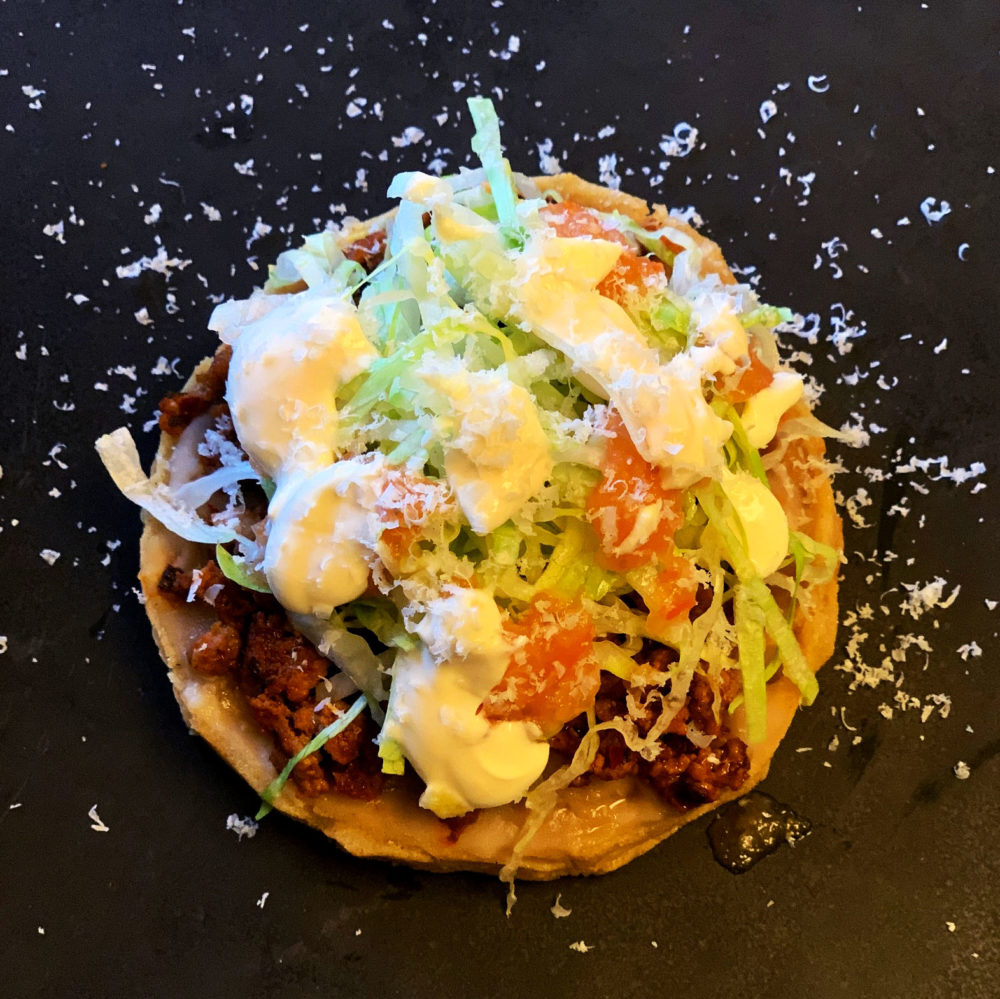
Masa Harina Ground Nixtamalized Corn Tortillas
- 1 cup (8 fl. oz./250 ml) water
- 6 tomatillo husks
- 1 cup (5 oz./155 g) (leveled) masa harina
- 1/2 tsp. sea salt
In a small saucepan over medium-high heat, heat the water with the tomatillo husks. Strain, discarding the husks, and let cool.
In a medium bowl, combine the masa harina, salt and tomatillo tea. Knead by hand for 5 to 8 minutes, then roll into portions (mini tortilla size is about 3/4 oz./24 g) and place a damp cloth on top to prevent the dough from drying out.
Cut along the seams of a resealable plastic bag to create two pieces of plastic that are slightly larger than the plates of your tortilla press. Place one of the plastic pieces on the bottom plate of the press. Place one of the dough balls on top of the plastic and cover with second piece of plastic. Drop the top of the press on top of the dough, press gently with the handle, then rotate the dough and pieces of plastic 180 degrees and just drop the lid again to ensure that the tortilla is thin and an even thickness. Repeat with the remaining dough.
On a comal or griddle over medium-high heat, cook each tortilla on one side for 1 minute and flip, pressing gently with a kitchen towel for 1 minute, then flip one last time. The tortilla should puff if it was kneaded enough.
Transfer the tortilla to a kitchen towel and cover to keep warm while you cook the remaining tortillas.
For the chorizo:
- 2 lb. (1 kg) ground pork
- 20 g salt
- 8 g chili powder
- 4 g sweet paprika
- 10 g minced garlic
- 2 Tbs. chopped fresh oregano or dried oregano
- 1 ancho chile, seeded, soaked and minced
- 1 g ground cumin seeds
- 1 g ground coriander seeds
- 10 g smoked paprika
- 1 g ground black pepper
- 1 g ground fennel seeds
- 4 g cayenne pepper
- 1 Tbs. red wine
For the tomato caldillo:
- 2 Roma tomatoes
- 1/2 yellow onion
- 4 garlic cloves
- 2 tsp. dried oregano
- 2 chiles de árbol (optional)
- 1 cup (8 fl. oz./250 ml) water
- Salt
For the sopes:
- 2 lb. (1 kg) fresh masa
- 1 cup (7 oz./220 g) refried pinto beans
- 1 head iceberg lettuce, thinly sliced
- Crema for serving
- Crumbled queso fresco for serving
- Fresh cilantro for serving
- Lime wedges for serving
To make the chorizo, in a large metal bowl, mix together the ground pork, salt, chili powder, paprika, garlic, oregano, ancho chile, cumin, coriander, smoked paprika, black pepper, fennel, cayenne and wine until well incorporated. Portion into small patties, each about 1/4 inch (6 mm) thick.
To make the tomato caldillo, in a pot over high heat, combine the tomatoes, onion, garlic, oregano, chiles de árbol and water. Cook until soft, about 10 minutes. Drain, discarding the liquid. Transfer the vegetable mixture to a blender and blend until thoroughly combined. Season to taste with salt.
In a fry pan over medium-high heat, cook the chorizo patties, 1 or 2 at a time, until browned on both sides and cooked through. Using a slotted spoon, transfer to a paper towel–lined plate. Save the rendered oil for the masa. Set the chorizo aside until ready to serve.
Grab a piece of masa about the size of a golf ball and flatten with a tortilla press or your hands until 1/4 inch (6 mm) thick. On a griddle or dry fry pan over medium-high heat, cook the masa for 3 minutes. Flip and cook on the other side for 3 minutes. Place on a flat surface until warm to the touch.
To make the sopes, pinch a small wall out of the inside of each thick masa cake. In a fry pan over medium-high heat, warm a few tablespoons of the reserved oil and fry the sopes on both sides. Transfer to a plate.
Layer the sopes first with the refried beans and chorizo, then spoon on the tomato caldillo (you will only need about half of it). Garnish with the lettuce, crema and queso fresco and cilantro and serve with lime wedges alongside. Serves 12.

5 comments
Some recipes is best and cool
My family members love ❣️ these recipes very much. Thanks for sharing this list.
Thanks for sharing this wonderful list of 5 recipes loved by 5 famous chefs. I also love all of these recipes mentioned in this post. I am a busy person,I have to work more than 10 hours at office (I gather information here gamb lizard -40 free spins no deposit ) and help the people who need to follow terms,policies and recommendation. I will try to have a taste few of these recipes in the weekend!
[…] Read More… […]
Thank you for sharing. Your website is awesome. Because I love to cook, especially for my kids! I love making new foods so they can enjoy a variety of delicious foods every day